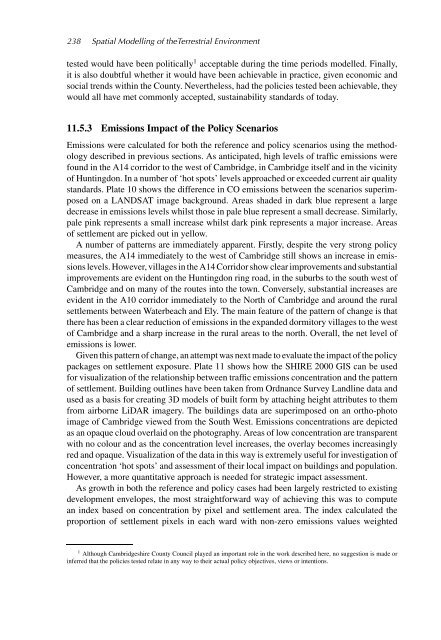1 Spatial Modelling of the Terrestrial Environment - Georeferencial
1 Spatial Modelling of the Terrestrial Environment - Georeferencial
1 Spatial Modelling of the Terrestrial Environment - Georeferencial
You also want an ePaper? Increase the reach of your titles
YUMPU automatically turns print PDFs into web optimized ePapers that Google loves.
238 <strong>Spatial</strong> <strong>Modelling</strong> <strong>of</strong> <strong>the</strong><strong>Terrestrial</strong> <strong>Environment</strong><br />
tested would have been politically 1 acceptable during <strong>the</strong> time periods modelled. Finally,<br />
it is also doubtful whe<strong>the</strong>r it would have been achievable in practice, given economic and<br />
social trends within <strong>the</strong> County. Never<strong>the</strong>less, had <strong>the</strong> policies tested been achievable, <strong>the</strong>y<br />
would all have met commonly accepted, sustainability standards <strong>of</strong> today.<br />
11.5.3 Emissions Impact <strong>of</strong> <strong>the</strong> Policy Scenarios<br />
Emissions were calculated for both <strong>the</strong> reference and policy scenarios using <strong>the</strong> methodology<br />
described in previous sections. As anticipated, high levels <strong>of</strong> traffic emissions were<br />
found in <strong>the</strong> A14 corridor to <strong>the</strong> west <strong>of</strong> Cambridge, in Cambridge itself and in <strong>the</strong> vicinity<br />
<strong>of</strong> Huntingdon. In a number <strong>of</strong> ‘hot spots’ levels approached or exceeded current air quality<br />
standards. Plate 10 shows <strong>the</strong> difference in CO emissions between <strong>the</strong> scenarios superimposed<br />
on a LANDSAT image background. Areas shaded in dark blue represent a large<br />
decrease in emissions levels whilst those in pale blue represent a small decrease. Similarly,<br />
pale pink represents a small increase whilst dark pink represents a major increase. Areas<br />
<strong>of</strong> settlement are picked out in yellow.<br />
A number <strong>of</strong> patterns are immediately apparent. Firstly, despite <strong>the</strong> very strong policy<br />
measures, <strong>the</strong> A14 immediately to <strong>the</strong> west <strong>of</strong> Cambridge still shows an increase in emissions<br />
levels. However, villages in <strong>the</strong> A14 Corridor show clear improvements and substantial<br />
improvements are evident on <strong>the</strong> Huntingdon ring road, in <strong>the</strong> suburbs to <strong>the</strong> south west <strong>of</strong><br />
Cambridge and on many <strong>of</strong> <strong>the</strong> routes into <strong>the</strong> town. Conversely, substantial increases are<br />
evident in <strong>the</strong> A10 corridor immediately to <strong>the</strong> North <strong>of</strong> Cambridge and around <strong>the</strong> rural<br />
settlements between Waterbeach and Ely. The main feature <strong>of</strong> <strong>the</strong> pattern <strong>of</strong> change is that<br />
<strong>the</strong>re has been a clear reduction <strong>of</strong> emissions in <strong>the</strong> expanded dormitory villages to <strong>the</strong> west<br />
<strong>of</strong> Cambridge and a sharp increase in <strong>the</strong> rural areas to <strong>the</strong> north. Overall, <strong>the</strong> net level <strong>of</strong><br />
emissions is lower.<br />
Given this pattern <strong>of</strong> change, an attempt was next made to evaluate <strong>the</strong> impact <strong>of</strong> <strong>the</strong> policy<br />
packages on settlement exposure. Plate 11 shows how <strong>the</strong> SHIRE 2000 GIS can be used<br />
for visualization <strong>of</strong> <strong>the</strong> relationship between traffic emissions concentration and <strong>the</strong> pattern<br />
<strong>of</strong> settlement. Building outlines have been taken from Ordnance Survey Landline data and<br />
used as a basis for creating 3D models <strong>of</strong> built form by attaching height attributes to <strong>the</strong>m<br />
from airborne LiDAR imagery. The buildings data are superimposed on an ortho-photo<br />
image <strong>of</strong> Cambridge viewed from <strong>the</strong> South West. Emissions concentrations are depicted<br />
as an opaque cloud overlaid on <strong>the</strong> photography. Areas <strong>of</strong> low concentration are transparent<br />
with no colour and as <strong>the</strong> concentration level increases, <strong>the</strong> overlay becomes increasingly<br />
red and opaque. Visualization <strong>of</strong> <strong>the</strong> data in this way is extremely useful for investigation <strong>of</strong><br />
concentration ‘hot spots’ and assessment <strong>of</strong> <strong>the</strong>ir local impact on buildings and population.<br />
However, a more quantitative approach is needed for strategic impact assessment.<br />
As growth in both <strong>the</strong> reference and policy cases had been largely restricted to existing<br />
development envelopes, <strong>the</strong> most straightforward way <strong>of</strong> achieving this was to compute<br />
an index based on concentration by pixel and settlement area. The index calculated <strong>the</strong><br />
proportion <strong>of</strong> settlement pixels in each ward with non-zero emissions values weighted<br />
1 Although Cambridgeshire County Council played an important role in <strong>the</strong> work described here, no suggestion is made or<br />
inferred that <strong>the</strong> policies tested relate in any way to <strong>the</strong>ir actual policy objectives, views or intentions.

















